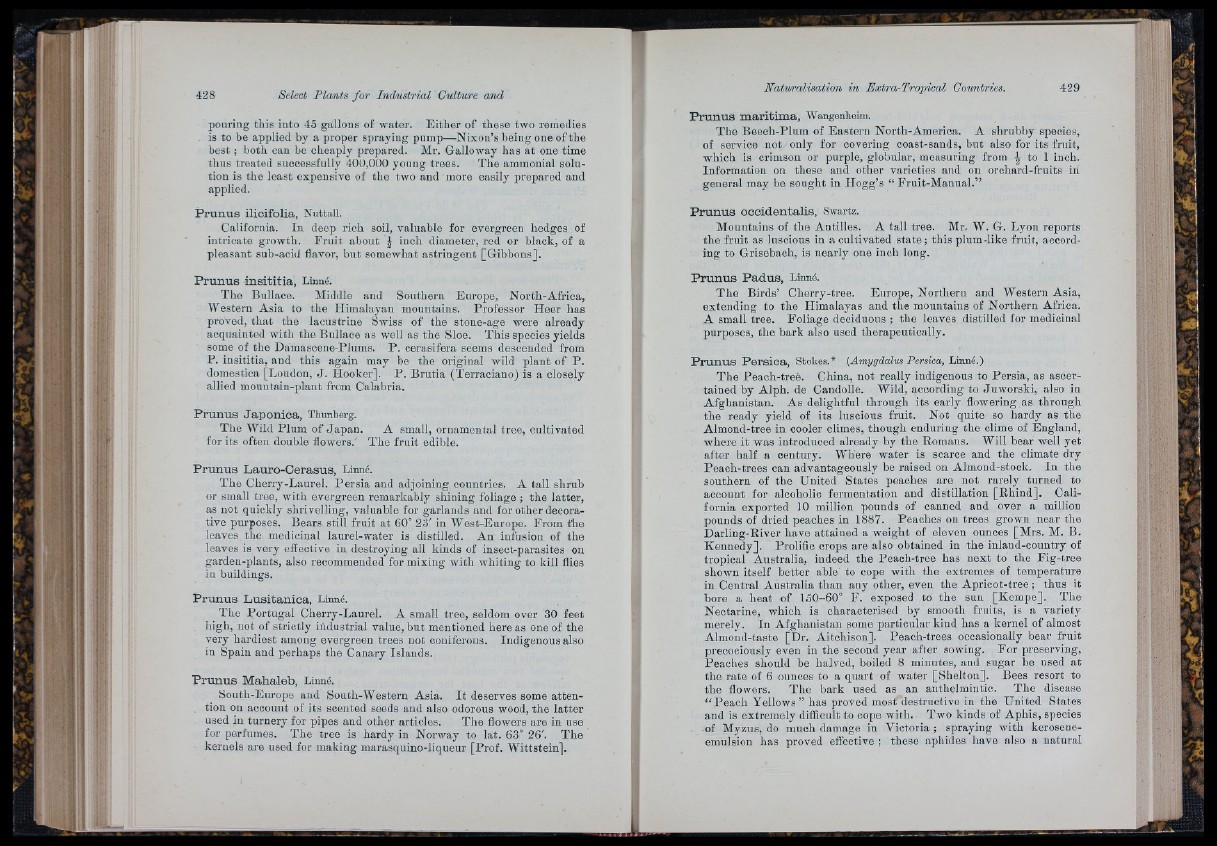
J ¥
Iii
pouring this into 45 gallons of water. Either of these two remedies
is to be applied by a proper spraying pmnp—Nixon’s being one of the
best ; both can be cheaply prepared. Mr. Galloway has a t one time
thus treated successfully 400,000 young trees. The ammonial solution
is the least expensive of the two and more easily prepared aud
applied.
Prunus ilicifolia, Nuttall.
California. In deep rich soil, valuable for evergreen hedges of
intricate growth. F ru it about J inoli diameter, red or black, of a
pleasant sub-acid flavor, but somewhat astringent [Gibbousl.
Prunus insititia, Linné.
Tbe Bullace. Middle and Southern Europe, Nortb-Africa,
Western Asia to the Himalayan mountains. Professor Heer bas
proved, th a t the lacustrine Swiss of the stone-age were already
acquainted with the Bullace as well as the Sloe. This species yields
some of the Damascene-Piiims. P. cerasifera seems descended from
P. insititia, and this again may he the original wild plant of P.
domestica [Loudon, J . Hooker]. P. Brutia (Terraciano) is a closely
allied mouutain-plant from Calabria.
Prunus Japónica, Thunberg.
The Wild Plum of Japan. A small, ornamental tree, cultivated
for its often double flowers. The fruit edible.
Prunus Lauro-Cerasus, Linné.
The Cherry-Laurel. Persia and adjoining countries. A tall shrub
or small tree, with evergreen remarkably shining foliage ; the latter,
as not quickly shrivelling, valuable for garlands and for other decorative
purposes. Bears still fruit at 60° 28' in West-Europe. From the
leaves the medicinal laurel-water is distilled. An infusion of the
leaves is very effective in destroying all kinds of insect-parasites on
garden-plants, also recommended for mixing with whiting to kill flies
in buildings.
Prunus Lusitanica, Linné.
The Portugal Cherry-Laurel. A small tree, seldom over 30 feet
high, not of strictly industrial value, but mentioned here as one of the
very hardiest among evergreen trees not coniferous. Indigenous also
iu Spain and perhaps the Canary Islands.
Prunus Mahaleb, Linné.
South-Europe and South-Western Asia. I t deserves some attention
on account of its scented seeds and also odorous wood, the latter
used iu turnery for pipes and other articles. The flowers are in use
for perfumes. The tree is hardy in Norway to lat. 63° 26'. The
kernels are used for making marasquino-liqueur [Prof. Wittstein].
Prunus maritima, Wangenheim.
The Beech-Pium of Eastern North-America. A shrubby species,
of service not only for covering coast-sands, but also for its fruit,
which is crimson or purple, globular, measuring from ^ to 1 inch.
Information on these and other varieties and on orchard-fruits in
general may be sought in Hogg’s “ Fruit-Manual.”
Prunus ccoidentalis, Swartz.
Mountains of tbe Antilles. A tall tree. Mr. W. G. Lyon reports
the fruit as luscious in a cultivated state; this p ium jik e fruit, according
to Grisebach, is nearly one inch long.
Prunus Padus, Linné.
The Birds’ Cherry-tree. Europe, Northern and Western Asia,
extending to the Himalayas and the mountains of Northern Africa.
A small tree. Foliage deciduous ; the leaves distilled for medicinal
purposes, the bark also used therapeutically.
Prunus Persica, Stokes.* [Amygdalus Perska, lAnné.)
The Peach-tree. China, not really indigenous to Persia, as ascertained
by Alph. de Candolle. Wild, according to Juworski, also in
Afghanistan. As delightful through its early flowering as through
the ready yield of its luscious fruit. Not quite so hardy as the
Almond-tree in cooler climes, though enduring the clime of England,
where it was introduced already by the Romans. Will bear well yet
after half a century. Where water is scarce and the climate dry
Peach-trees can advantageously he raised on Almond-stock. In the
southern of the United States peaches are not rarely turned to
account for alcoholic fermentation and distillation [Rhind]. California
exported 10 million pounds of canned and over a million
pounds of dried peaches in 1887. Peaches on trees grown near the
Darling-River have attained a weight of eleven ounces [Mrs. M. B.
Kennedy], Prolific crops are also obtained in the inland-country of
tropical Australia, indeed the Peach-tree has next to the Fig-tree
shown itself better able to cope with the extremes of temperature
in Central Australia than any other, even the Apricot-tree; thus it
bore a heat of 150-60° F. exposed to the sun [Kempe]. The
Nectarine, which is characterised by smooth fruits, is a variety
merely. In Afghanistan some particular kind has a kernel of almost
Almond-taste [Dr. Aitchison]. Peach-trees occasionally bear fruit
precociously even in the second year after sowing. For preserving,
Peaclies should be halved, boiled 8 minutes, and sugar be used at
the rate of 6 ounces to a quart of water [Shelton]. Bees resort to
the flowers. The bark nsed as an anthelmintic. The disease
“ Peach Yellows” has proved most destructive in the United States
and is extremely difficult to cope with. Two kinds of Aphis, species
of Myzus, do much damage in Victoria ; spraying with kerosene-
omulsion has proved effective ; these aphides have also a natural